“That’s NOT how it is in my family!”: Children Develop Intercultural Understandings of Themselves and Others
By Michelle Hassay Doyle
This vignette describes explorations with students arising from a literacy community that examined how global picture books support children’s intercultural understanding of themselves and others as cultural beings. Please see Building Intercultural Understandings through Global Literature: An Introduction to Our Work by Prisca Martens and Ray Martens for an overview of this literacy community’s work.
To help the children think about what makes them unique cultural beings we created a text set of books that focused on different aspects of who they are, including their relationships, ethnicity, gender, language, etc. (Geertz, 1973). With an understanding of themselves, we believed they would also value, respect, and celebrate the uniqueness in each other. Banks (2004) states, “Self-acceptance is a prerequisite to the acceptance and valuing of others” (p. 302).
We began this exploration of identity with families and what makes each family unique and special. We did this for a several reasons. First, children’s families play a major role in who they are as individuals. Family histories, traditions, religious beliefs, experiences, etc. all influence children’s values and perspectives of themselves, each other, and the world. Second, as described in the introductory vignette, the children were bringing information on their family origins that we were plotting on the world maps and timelines. Discussions of how families are alike, different, and special were evolving naturally out of that. Finally, the first grade social studies unit at the time was on families and in second grade was on neighborhoods which also made a focus on families a logical starting place.
In this article I’ll share highlights from our focus on families and self and how the children demonstrated their intercultural understandings through their experiences with global literature.
Our Families Are Unique and Special
Once we knew we would be studying children’s intercultural understandings in the spring, Jenna and I decided to send the family origin survey to the parents of our first graders in early December. We added a question to those Prisca and Ray listed in their vignette that asked parents about their family’s cultural traditions during the holiday season. The parents eagerly responded. Yesha’s mother, for example, explained that they celebrated Dwali and sent us background information to use. During the week before winter break we focused on different fall/winter cultural traditions, including Dwali, Las Posadas, Christmas, Hanukkah, and Kwanza. When we discussed similarities and differences between the different celebrations, the children pointed out that all of them involve light.
In addition, in my classroom, with the help of Mrs. Nelson, my room parent, the children brought in family recipes that were special to them around the holiday season. I introduced this by sharing a recipe that originated in Czechoslovakia, the country that my family originated from, and that my mother and I make each December. The children also wrote about and illustrated special traditions their families keep throughout the year and how they celebrated them. These experiences helped us begin discussions of culture.
After winter break we read You and Me Together: Moms, Dads, and Kids Around the World (Kerley, 2010). Before reading the book, we brainstormed on a web what children knew about families. The children suggested topics such as families have different people, come from different places, do different things, and have friends. We asked the children to look for other information as we read the book. The children made rich comments and connections. One page, for example, contains a photograph of a young girl and her mother whose cheeks are smeared with different colors. When the second graders were reading the book, two girls, one from Nepal and the other from India, simultaneously blurted out, “Holi!” They explained to their classmates that Holi is a festival that celebrates the arrival of spring and then shared some of their experiences.
Following reading the book, we went back to the webs and the children added new insights, such as families work together, eat different foods, wear different kinds of clothes and jewelry, and have different religions. As we discussed the book further in my class, other interesting conversations emerged. Brendan, for example, commented, “My mom takes care of the family and my dad makes the money” to which Tate quickly responded, “That’s NOT how it is in my family!” Our discussions helped the children appreciate the uniqueness of their own families.
At the conclusion of this discussion we asked children to create heart maps in their sketchbooks. After drawing a large heart, the children drew or wrote inside the heart what was unique and special about their families. Their heart maps included such images as family members, places their families go (i.e., beach, amusement park), things they do together (i.e., play board games or sports, watch television), favorite foods they eat (i.e., pizza, chicken), and religious places they attend together (i.e., church, synagogue, temple). Brendan’s (see Figure 1) and Kaylie’s (see Figure 2) heart maps are examples.
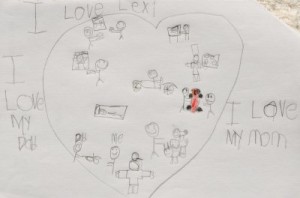 Figure 1: Brendan drew things his family does together, such as vacation, take care of the pets, and eat. He surrounded his heart map with statements of love for his parents and sister.
Figure 1: Brendan drew things his family does together, such as vacation, take care of the pets, and eat. He surrounded his heart map with statements of love for his parents and sister.
Figure 2. Kaylie included holiday celebrations, games her family plays together, family members, etc., in her heart map.
We Are Each Unique and Special
Suki’s Kimono (Uegaki, 2005) was the first book we read to help children consider aspects of who they are in both observable ways others can see as well as inwardly in their hearts. Suki is a young girl who proudly wears her Japanese kimono and geta (wooden clogs) from her grandmother on the first day of school, even though her older sisters discourage her because those clothes aren’t “cool”. To allow the children to reflect and inquire, we read the book through and then asked for their thoughts. The discussions in each classroom were rich! In my classroom Prisca at one point asked, “Why don’t Suki’s sisters want to walk with her?” Kaden responded, “They are embarrassed by what she is wearing.” Linda immediately blurted out, “Like some big sisters ignore you, just like my sister ignores me.” Later, when Prisca asked, “Why didn’t Suki fight back when her classmates teased her?” Davis stated, “She was proud she got [the kimono] and didn’t care if anyone else didn’t like it!”
Following the discussion, Ray highlighted several illustrations to help the children think about the decisions the artist Stephane Jorisch made when she created the illustrations. On the page where the taiko drummers are performing, for example, he asked the children how the drums sounded and how they knew that. The children talked about Jorisch’s use of color splotches and diagonal lines (i.e., swinging lanterns, blowing hair) to show the loudness of the drums at the celebration and the energy their noise created. On the page where Suki is dancing the children described how they knew Suki was moving and what she was feeling.
To help the children think about the beliefs and values Suki, her classmates, and her sisters held in their hearts, we introduced the children to cultural x-rays (Short, 2009). Ray outlined three figures on a large piece of paper, labeled the one in the middle “Suki”, and each of the other two “Others” and “Sisters”. We asked the children what was important to Suki and they responded with statements like, “she loves herself”, “she likes her kimono,” “she loves her obachan (grandmother),” and “she is happy and proud” which we wrote in Suki’s heart on the outline. When we asked what was important to the others the children said, “They wanted everyone to look the same” and her sisters “wanted to be cool and look like everyone else”. On the outside of the figures the children suggested physical and visible features of Suki, her sisters, and the others that we drew. The children’s comments indicated to us that they were distinguishing between outer visible aspects of culture and inner aspects of who they are.
We asked the children to think about something they are proud to wear either at school or someplace else and draw that in their sketchbooks, thinking also about line and color. Many children picked up on wearing something “cool” and drew clothes such as sports uniforms, favorite shirts, etc. Davis drew himself in his favorite jersey (see Figure 3) and wrote, “This is me, Davis. I like my jersey. [My jersey] is cool to me. by Davis.”
Figure 3. Davis is proud to wear his jersey.
Yesha drew herself in a dress and wrote, “I would want to wear a dress because it is cool to wear it. But my mother won’t let me because it is not summer if it was summer. But in summer we have a summer vacation. That is the only time when I can wear it but I can wear it in the weekend” (see Figure 4).
Figure 4. Yesha drew herself proudly wearing a dress.
Other children drew clothes related to their cultural backgrounds. Richard, a first grader, is Korean and wrote, “I wish I could wear my Hanbok [Korean traditional clothing] to school but I can’t because it is not a special occasion.” Grant, a second grader, drew himself wearing African clothes (see Figure 5). When asked about his drawing he said,
That’s me and I have African clothes. I only have one but it’s really special so I don’t wear it to school much but I really want to. My mom says no because people will laugh at me. I’m dancing an African dance [that] someone from Africa showed me. I showed I was dancing by putting lines and my feet up and my arms are moving. I feel happy because I like wearing my African clothes.
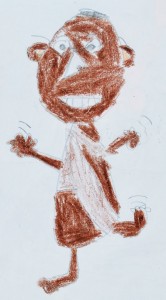 |
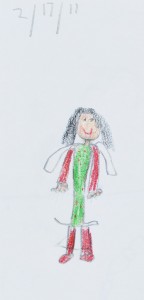 |
|
Figure 5. Grant drew himself doing an African dance while wearing his African clothes. |
Figure 6. Harita drew herself wearing her ghagra choli that she wears on Eid and other special occasions |
Harita drew herself wearing her ghagra choli and said, “The scarf is normally red and my dress is green with patterns on it. I wear it on Eid or other special times” (see Figure 6).
For the other books in the text set we followed a similar procedure of reading, letting the children respond and orally discussing the story, examining the artist’s use of line and color, and inviting the children to respond in their sketchbooks. These books included Sebastian’s Roller Skates (de Deu Prats, 2005), Guji Guji, (Chen, 2004), and Am I a Color Too? (Cole & Vogl, 2005).
Sharing Who We Are
After reading the books in this text set we provided the children with two opportunities to share their understandings of themselves and who they are as cultural beings. First, each child created a cultural x-ray. The children had some understanding of cultural x-rays from those we created together with Suki’s Kimono and other stories we’d read. The teachers further demonstrated cultural x-rays by doing think-alouds to create their own. Then each child received an 11” x 17” piece of paper with the outline of a figure and set to work.
The second opportunity to represent their understandings of themselves came after we read Millie’s Marvelous Hat (Kitamura, 2009), following the cultural x-rays. In the story, when Millie doesn’t have enough money to purchase a hat she sees in a store window, the salesman finds her the perfect hat she can afford: one that she imagines that changes to what she is thinking and feeling. After reading the book, we invited the children to draw themselves (on 11” x 17” paper) wearing a hat that showed who they are and what is special about them.
The cultural x-rays and hats proved to be powerful ways for the children to express their understandings. While there usually was some overlap in the information provided in each engagement, the x-rays and hats also evoked different kinds of information. The hats usually contained images of activities, people, foods, etc., that were important to the children while the x-rays typically contained more writing. The writing not only named important people and things but also listed characteristics the children attributed to themselves. Many children also thoughtfully chose colors and lines in their x-rays and/or hats to symbolize aspects of who they are. Through the cultural x-rays and hats the children explored, wove together, and represented their strengths, interests, backgrounds, talents, and the influences that make them who they are. The hats and cultural x-rays were also eye-opening for us and provided windows to knowing the children more deeply.
Below are examples of the cultural x-rays and hats. Since a summary of the children’s explanations cannot possibly capture the richness of their thoughts, audio files of them talking about their work are attached.
First Grade Examples: Brendan and Jordan
See Figure 7 for Brendan’s cultural x-ray and a clip of Brendan discussing his work. Figure 8 shows Brendan’s hat and Brendan talking about what he drew.
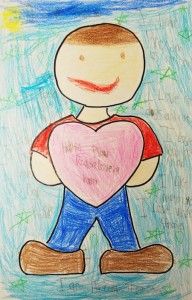 |
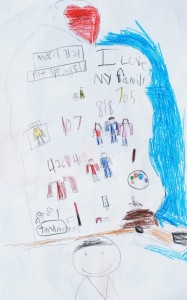 |
|
Figure 9. Brendan’s Cultural X-Ray Audio Clip |
Figure 8. Brendan’s Hat Audio-Clip |
In Figure 9 Jordan explains his cultural x-ray. See Figure 10 for his hat and description of his work.
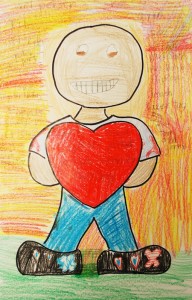 |
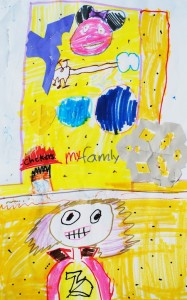 |
|
Figure 9. Jordan’s cultural x-ray. Audio-Clip |
Figure 10. Jordan’s Hat Audio-Clip |
Second Grade Examples: Connor and Nina
Connor talks about his cultural x-ray in Figure 11. He explains his hat in Figure 12.
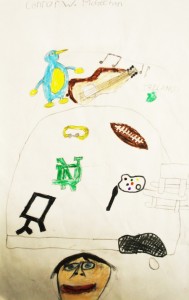 |
|
|
Figure 11. Connor’s cultural x-ray. Audio-Clip |
Figure 12. Connor’s Hat Audio-Clip |
See Figure 13 to hear Nina talking about her cultural x-ray and Figure 14 for Nina’s explanation of her hat.
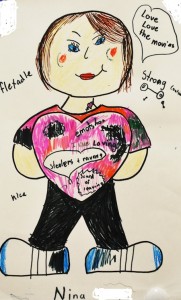 |
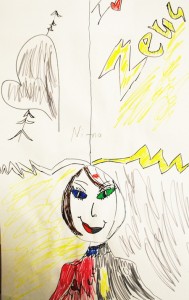 |
|
Figure 13. Nina’s cultural x-ray. Audio-Clip |
Figure 14. Nina’s Hat Audio-Clip |
Through the Identity Text Set children gained an appreciation not only for their own uniqueness but for that of their classmates. Understandings were built on discussions related to culture that began with the maps and timelines and continued through our readings of and experiences with global literature. The children’s intercultural understandings were evident in their deepening caring and sensitivity to each others’ individuality and their growing awareness and appreciation of the differences that made them who they are, including their families, backgrounds, experiences, traditions, etc. All of this they worked to express in their artwork. The word “respectful” from our school code of conduct had a richer meaning and value to each of our children.
References
Banks, J. (2004). Teaching for social justice, diversity, and citizenship in a global world. The Educational Forum, 68, 296-305.
Chen, C. (2004). Guji, Guji. La Jolla, CA: Kane/Miller.
Cole, H., & Vogl, N. (2005). Am I a color too? Illustrated by G. Purnell. Bellevue, WA: Illumination Arts.
de Deu Prats, J. (2005). Sebastian’s roller skates. Illustrated by F. Rovira. La Jolla, CA: Kane/Miller.
Geertz, C. (1973). The interpretation of cultures. New York: Basic Books.
Kerley, B. (2010). You and me together: Moms, dads, and kids around the world. National Geographic Children’s Books.
Kitamura, S. (2009). Millie’s marvelous hat. 21st Century.
Short, K. (2009). Critically reading the word and the world: Building intercultural understanding through literature. Bookbird: A Journal of International Children’s Literature, 47(2), 1-10.
Uegaki, C. (2005). Suki’s kimono. Illustrated by S. Jorisch. Tonawanda, NY: Kids Can Press.
Michelle Doyle is a first grade teacher at Pot Spring Elementary School in Timonium, Maryland. She can be contacted at mdoyle3@bcps.org.
WOW Stories, Volume IV, Issue 1 by Worlds of Words is licensed under a Creative Commons Attribution-NonCommercial-ShareAlike 4.0 International License.
Based on a work at https://wowlit.org/on-line-publications/stories/storiesiv1/.

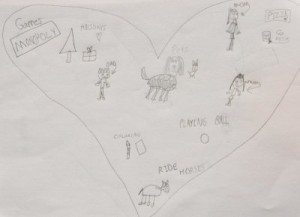
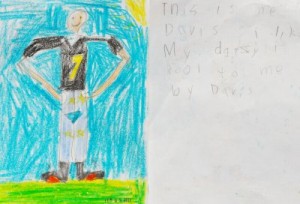
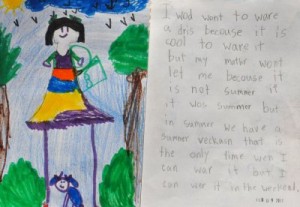
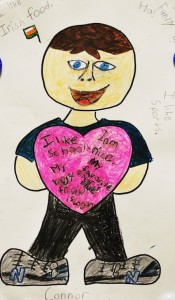
I wish that more teachers took such an innovative approach to embracing our cultures. As an American, I embody several different culture through our families bloodlines. We celebrate holidays with many Polish and German traditions. Through our celebrations, I have been able to inform many people about how our culturevhas had an impact on my life and my families life. These students now have a basic understanding that we are all different and yet all the same. If every teacher took advantage of this opportunity, there would be so much more tolerance of other cultures and may create a general sense of intrigue to understand them. I do hope that more teachers read this and implement these strategies into their classrooms to better the future of our great nation.